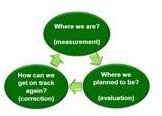Introduction to Kaizen and the Kaizen Philosophy in Project Management
A Process of Continuous Improvement
Kaizen means continuous improvement, and was a philosophy developed by engineers involved with manufacturing cars at Toyota. It basically refers to continuous improvements in all stages of any process with every small improvement making its own contribution to the process. As every step is a small one, it is easily assimilated within a team and produces immediate results. All the people involved in the process are encouraged to continuously examine the process and their own contribution to it, to see if they can effect any improvement in it and thereby save time, effort or resources. The Kaizen philosophy is mainly used when trying to improve an existing system.
Kaizen Blitz
A Kaizen blitz or event is when the entire team involved in a process focuses on one particular aspect in order to improve its efficiency and
performance. As everyone is involved, all facets of that particular event are examined, and with the breadth of the experience going into the thinking, the event itself is bound to find some particular idea or ideas that have not been examined previously. By tackling all aspects of a process, the improvements are real and continuous and result in remarkable achievements. This leads to a lean manufacturing program that is very economical in terms of time, effort and resources. This can only add to the overall profitability of a company and its efficiency in operations.
Kaizen Philosophy and Project Management
Any project involves the assemblage of men, materials and money to produce a particular result. This may involve building a new road or building, developing a new software program or even putting together an event. Every project has a number of stages and steps, each one of which is very vital to the successful completion of the project. So how does one apply the Kaizen philosophy to project management?
Every project has different stages and milestones. Each of these has their own particular requirements and efforts needed for its completion. By applying the Kaizen philosophy of continual improvement, it is possible to achieve economies of time and resources in each of them. It is also likely that some particular stage may be completed earlier or more economically than earlier envisioned. This frees resources for deployment in other stages of the project. The project manager will have to be constantly vigilant to see that the freed resources do not remain idle and are utilized elsewhere.
Kaizen events are never long drawn out, sustained processes. They are limited to very short periods of time and this continuous improvement involves planning, doing, checking and acting. It is therefore more suited to the Agile method of project management than the Waterfall method, as the Agile method is very flexible. The breakdown of the project into small doable segments makes it very easy to opt for continuous improvement as each stage of the project is completed.
Kaizen should never be an option for drastic changes or innovations. Persons involved in the process continue to work under conditions and environments that they are familiar with. This is very essential for the comfort level that they have, which in turn leads to more commitment and thinking, which can only help the Kaizen concept. Any changes that are suggested or accepted by the team are easily implemented because of their familiarity with the process. This leads to uninterrupted work with the changeovers made almost seamlessly.
Any stage of a project which is handled in the same way as previous ones leads to a stagnation in thinking and probably even a sense of boredom. As Kaizen thinking leads to newer ways of doing the same work with the adoption of newer techniques or technology, this keeps the enthusiasm of the team involved from flagging. And an enthusiastic team can only be more involved and therefore more capable of making the small improvements that are basic to the Kaizen philosophy.
Image Credit: Wikimedia Commons
